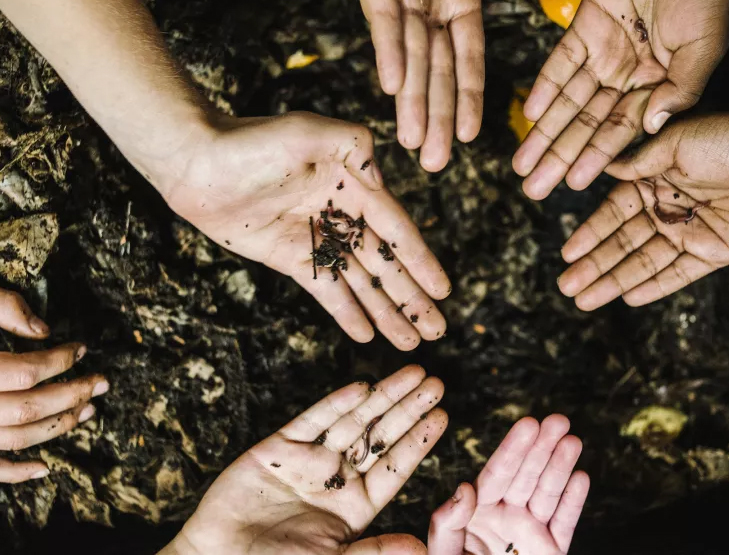Municipal solid waste composting
What is composting?
Composting is the natural process of recycling organic matter, such as leaves and food scraps, into a valuable fertilizer that can enrich soil and plants. Anything that grows decomposes eventually; composting simply speeds up the process by providing an ideal environment for bacteria, fungi, and other decomposing organisms (such as worms, sowbugs, and nematodes) to do their work. The resulting decomposed matter, which often ends up looking like fertile garden soil, is called compost. Fondly referred to by farmers as “black gold,”

Composting is the natural biological process in which degradable part of waste is transformed to a stable material with excellent characteristics for application on soils. Thus it requires a pretreatment such as removal of big fractions and other contaminants that could affect the composting process and final quality of compost. Such type of technique must be effective efficient and less costly Agricultural application of composted Municipal Solid Waste, as nutrient source for plants and as soil conditioner, is the most cost effective option of MSW management.
Municipal solid waste composting process
Municipal Solid Waste (MSW) composting is a rapidly growing method of solid waste management . MSW includes the residential, commercial, and institutional solid waste generated within a community. MSW composting is the process by which the organic, biodegradable portion of MSW is microbiologically degraded under aerobic conditions.
During the process of degradation, bacteria are used to decompose and break down the organic matter into water and carbon dioxide , which produces large amounts of heat and water vapor in the process. Given sufficient oxygen and optimum temperatures, the composting process achieves a high degree of volume reduction and also generates a stable end product called compost that can be used for mulching, soil amendment, and soil enhancement. As a form of solid waste management, MSW composting reduces the amount of waste that would otherwise end up in landfills.
Here are some commonly used machines and the basic steps involved in the process:
Common Equipment
1. Raw Material Crushers: Used to break down large pieces of organic material into smaller pieces, making mixing and decomposition easier.
2. Mixers/Stirrers: Used to blend different organic materials (such as food scraps, straw, wood chips) along with any necessary additives (like limestone powder to adjust pH).
3. Windrow Turners: Used to turn compost piles to ensure adequate oxygen supply, promoting microbial activity.
4. Conveyor Belts: Used for transporting raw materials or semi-finished products, reducing manual handling and improving efficiency.
5. Temperature and Humidity Monitoring Systems: Used to monitor temperature and humidity levels during the composting process to ensure suitable conditions.
6. Screeners: Used after the composting is complete to sift out undecomposed large particles or other impurities.
7. Packaging Machines: Used to package the final product for sale and storage.
| Model | TC-2400 | TC-2600 |
| Turning Width(mm) | 2400 | 1100-1300 |
| Turning Height(mm) | 600-1000 | 12000-29000 m³/h |
| Max.Diameter of Material Particles(mm) | 250 | 250 |
| Working Knife Diameter(mm) | 400 | 500 |
| Capacity(m³/h) | 500-700 | 1000-1200 |
-
 Trommel screenTrommel screen, also known as drum screens, are widely used in various industries for sorting and separating materials.Get Quote
Trommel screenTrommel screen, also known as drum screens, are widely used in various industries for sorting and separating materials.Get Quote -
 Crop straw double shaft shreddApplications:Biomass Energy Production: Shredded straw can be used as a feedstock for bioenergy plants to produce electricity or heat.Livestock Feed: Reduced-si...Get Quote
Crop straw double shaft shreddApplications:Biomass Energy Production: Shredded straw can be used as a feedstock for bioenergy plants to produce electricity or heat.Livestock Feed: Reduced-si...Get Quote -
 Zhongcheng Air Drum SeparatorAir drum separators effectively separate lightweight materials (e.g., plastics, paper) from heavier materials (e.g., metals, glass). This high efficiency is cru...Get Quote
Zhongcheng Air Drum SeparatorAir drum separators effectively separate lightweight materials (e.g., plastics, paper) from heavier materials (e.g., metals, glass). This high efficiency is cru...Get Quote
-
2024-08-07Tire double shaft shredderOperation:Feeding: Whole or pre-cut tires are fed into the shredder through an inlet hopper.Shredding: As the tires enter the shredding chamber, the rotating cu...
-
2023-01-18RDF Making MachineRDF (Refuse Derived Fuel) making machine is a specialized equipment used in waste management and energy recovery processes. Its primary function is to convert v...
-
2024-08-16Crop straw double shaft shredderApplications:Biomass Energy Production: Shredded straw can be used as a feedstock for bioenergy plants to produce electricity or heat.Livestock Feed: Reduced-si...
-
2025-03-03Mini Copper Wire GranulatorThe copper wire granulator machine is a device specially used to process waste wires and cables. Its main function is to separate the copper and plastic in the ...
-
2023-01-12Waste Baler For MSWHigh density solid waste balers are the final step before sending waste to landfill. Horizontal balers designed and manufactured for this difficult job and prov...



